Mathematical modelling and optimal control of production losses caused by Miridae
IF 2.1
4区 数学
Q2 MATHEMATICAL & COMPUTATIONAL BIOLOGY
引用次数: 0
Abstract
Cocoa mirid, Sahlbergella singulars , is the major pest of cocoa ( Theobroma cacao ) responsible of several damage in plots in West Africa and particularly in Cameroon. Occasional damage accounts for 30 40% of pod losses. However, when miridae affect the foliage, gradual wilting occurs and eventually, tree death. A few studies have focused on describing the time evolution of Miridae in the plot in Cameroon, yet numerous questions remain. The aim of this paper is to estimate and control the losses of production caused by the bites of miridea. To do this, we will formulate and study a mathematical model for the dynamics of pods that takes into account the feeding and egg-laying of adults miridae on pods. We present the theoretical analysis of the model. More precisely, we compute equilibria and derive a threshold parameter that determines the presence or not of miridae in the plot. Throughout numerical simulations, we found that miridae can cause approximately 39.21% of production losses (which represents approximatively USD 1276.8 revenue losses) when initially, one has 1200 plants in the plot. After, we aim to increase cocoa production through optimal control. Optimal control consists in reducing density the number of nymphs and adults miridae in the plot. We studied the controlled model and we found that losses with control shrink to 20.58% which corresponds to USD670.32 income revenue.Miridae生产损失的数学建模及优化控制
可可螟,即单一萨尔伯格菌,是可可(可可树)的主要害虫,在西非,特别是在喀麦隆造成了几起破坏。偶尔的伤害占豆荚损失的30 - 40%。然而,当mirridae影响树叶时,逐渐发生枯萎,最终导致树木死亡。一些研究集中于描述喀麦隆情节中Miridae的时间演变,但仍存在许多问题。本文的目的是为了估计和控制因蠓叮咬造成的生产损失。为了做到这一点,我们将制定和研究一个数学模型的豆荚动力学,考虑到成虫在豆荚上的摄食和产卵。对该模型进行了理论分析。更准确地说,我们计算平衡并推导出一个阈值参数,该参数决定了图中是否存在miridae。通过数值模拟,我们发现,当最初在地块中有1200个植物时,miridae可以造成大约39.21%的生产损失(相当于大约1276.8美元的收入损失)。之后,我们的目标是通过最优控制来提高可可产量。最优控制包括降低田中若虫和成虫的密度和数量。我们研究了控制模型,我们发现控制下的损失缩小到20.58%,对应于670.32美元的收入收入。
本文章由计算机程序翻译,如有差异,请以英文原文为准。
求助全文
约1分钟内获得全文
求助全文
来源期刊

Mathematical Modelling of Natural Phenomena
MATHEMATICAL & COMPUTATIONAL BIOLOGY-MATHEMATICS, INTERDISCIPLINARY APPLICATIONS
CiteScore
5.20
自引率
0.00%
发文量
46
审稿时长
6-12 weeks
期刊介绍:
The Mathematical Modelling of Natural Phenomena (MMNP) is an international research journal, which publishes top-level original and review papers, short communications and proceedings on mathematical modelling in biology, medicine, chemistry, physics, and other areas. The scope of the journal is devoted to mathematical modelling with sufficiently advanced model, and the works studying mainly the existence and stability of stationary points of ODE systems are not considered. The scope of the journal also includes applied mathematics and mathematical analysis in the context of its applications to the real world problems. The journal is essentially functioning on the basis of topical issues representing active areas of research. Each topical issue has its own editorial board. The authors are invited to submit papers to the announced issues or to suggest new issues.
Journal publishes research articles and reviews within the whole field of mathematical modelling, and it will continue to provide information on the latest trends and developments in this ever-expanding subject.
 求助内容:
求助内容: 应助结果提醒方式:
应助结果提醒方式:


